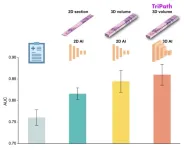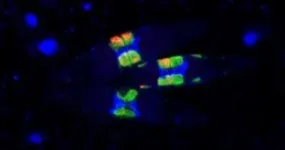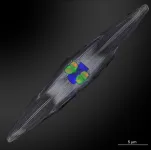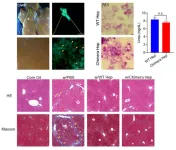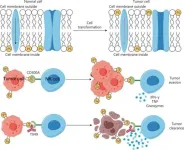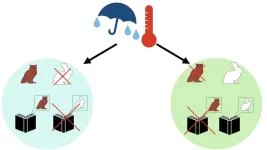(Press-News.org) Researchers developed Tripath to bridge computational gaps to process 3D tissue and predict outcomes based on 3D morphological features
Cancer recurrence models trained on 3D tissue volumes outperformed models trained on 2D tissue images
Human tissue is intricate, complex and, of course, three dimensional. But the thin slices of tissue that pathologists most often use to diagnose disease are two dimensional, offering only a limited glimpse at the tissue’s true complexity. There is a growing push in the field of pathology toward examining tissue in its three-dimensional form. But 3D pathology datasets can contain hundreds of times more data than their 2D counterparts, making manual examination infeasible.
In a new study, researchers from Mass General Brigham and their collaborators present Tripath: new, deep learning models that can use 3D pathology datasets to make clinical outcome predictions. In collaboration with the University of Washington, the research team imaged curated prostate cancer specimens, using two 3D high-resolution imaging techniques. The models were then trained to predict prostate cancer recurrence risk on volumetric human tissue biopsies. By comprehensively capturing 3D morphologies from the entire tissue volume, Tripath performed better than pathologists and outperformed deep learning models that rely on 2D morphology and thin tissue slices. Results are published in Cell.
While the new approach needs to be validated in larger datasets before it can be further developed for clinical use, the researchers are optimistic about its potential to help inform clinical decision making.
“Our approach underscores the importance of comprehensively analyzing the whole volume of a tissue sample for accurate patient risk prediction, which is the hallmark of the models we developed and only possible with the 3D pathology paradigm,” said lead author Andrew H. Song, PhD, of the Division of Computational Pathology in the Department of Pathology at Mass General Brigham.
“Using advancements in AI and 3D spatial biology techniques, Tripath provides a framework for clinical decision support and may help reveal novel biomarkers for prognosis and therapeutic response,” said co-corresponding author Faisal Mahmood, PhD, of the Division of Computational Pathology in the Department of Pathology at Mass General Brigham.
“In our prior work in computational 3D pathology, we looked at specific structures such as the prostate gland network, but Tripath is our first attempt to use deep learning to extract sub-visual 3D features for risk stratification, which shows promising potential for guiding critical treatment decisions,” said co-corresponding author Jonathan Liu, PhD, at the University of Washington.
Authorship: In addition to Faisal Mahmood, Mass General Brigham authors include Andrew H. Song, Mane Williams, Drew F.K. Williamson, Guillaume Jaume, Andrew Zhang, Bowen Chen. Additional authors include Sarah S.L. Chow, Gan Gao, Alexander S. Baras, Robert Serafin, Richard Colling, Michelle R. Downes, Xavier Farré, Peter Humphrey, Clare Verrill, Lawrence D. True, Anil V. Parwani and co-corresponding author Jonathan T.C. Liu.
Disclosures: Song and Mahmood are inventors on a provisional patent that corresponds to the technical and methodological aspects of this study. Liu is a co-founder and board member of Alpenglow Biosciences, Inc., which has licensed the OTLS microscopy portfolio developed in his lab at the University of Washington.
Funding: Authors report funding support from the Brigham and Women’s Hospital (BWH) President’s Fund, Mass General Hospital (MGH) Pathology, the National Institute of General Medical Sciences (R35GM138216), Department of Defense (DoD) Prostate Cancer Research Program (W81WH-18-10358 and W81XWH-20-1-0851), the National Cancer Institute (R01CA268207), the National Institute of Biomedical Imaging and Bioengineering (R01EB031002), the Canary Foundation, the NCI Ruth L. Kirschstein National Service Award (T32CA251062), the Leon Troper Professorship in Computational Pathology at Johns Hopkins University, UKRI, mdxhealth, NHSX, and Clarendon Fund.
Paper cited: Song AH et al. “Analysis of 3D pathology samples using weakly supervised AI” Cell DOI: 10.1016/j.cell.2024.03.035
END
AI advancements make the leap into 3D pathology possible
Researchers developed Tripath to bridge computational gaps to process 3D tissue and predict outcomes based on 3D morphological features
2024-05-09
ELSE PRESS RELEASES FROM THIS DATE:
Net zero plans show limited climate ambition on ‘residual’ emissions
2024-05-09
New research by the University of East Anglia (UEA) reveals what countries think will be their most difficult to decarbonise sectors when they reach net zero, with agriculture expected to be responsible for the largest remaining emissions.
Once countries have taken the ‘easy’ steps to get to net zero - such as switching to more renewable electricity, electric cars, and heat pumps for homes - they are still left with some sources of emissions.
These ‘residual’ emissions continue to be emitted at the ...
New Rhizobia-diatom symbiosis solves long-standing marine mystery
2024-05-09
Nitrogen is an essential component of all living organisms. It is also the key element controlling the growth of crops on land, as well as the microscopic oceanic plants that produce half the oxygen on our planet. Atmospheric nitrogen gas is by far the largest pool of nitrogen, but plants cannot transform it into a usable form. Instead, crop plants like soybeans, peas and alfalfa (collectively known as legumes) have acquired Rhizobial bacterial partners that “fix” atmospheric nitrogen into ammonium. This partnership makes legumes one of the most important ...
New stem cell research may have implications for liver transplantation
2024-05-09
Liver disease, due to viral infections, alcohol abuse, obesity, or cancer, accounts for 1 in every 25 deaths worldwide. A liver transplant can be life saving for people with end-stage liver disease. However, the procedure has limitations related to donor shortage, a technically challenging and invasive surgical procedure, and the requirement for lifelong immunosuppressive medication in the transplant recipients. An alternative to whole organ transplantation is the less invasive injection of dissociated human liver cells, but donor shortage is still an issue. Utilizing ...
New cells could be key to treating obesity
2024-05-09
Understanding how fat tissue forms and functions is crucial for addressing obesity and related metabolic diseases. However, adipose tissue, or body fat, behaves differently based on its location in the body.
Take, for example, the omentum: a large, apron-like fatty tissue hanging from the stomach that covers organs within the peritoneum, such as the stomach and intestines. It not only stores fat but also plays roles in immune regulation and tissue regeneration.
Omental adipose tissue is associated with ...
Supercharging immune cells to battle blood cancer: Breakthrough in cancer immunotherapy
2024-05-09
A new study reveals a groundbreaking approach to immunotherapy, demonstrating that blocking the interaction between the CD300A receptor and phosphatidylserine (PS) significantly enhances the ability of human natural killer (NK) cells to lyse hematologic malignancies (HMs).
Cancer has a profound impact on human life, and immune checkpoint therapy (ICT) has made remarkable strides in cancer treatment. However, ICT faces challenges such as low overall response rates and the emergence of immune-related adverse events. To overcome these hurdles, researchers are exploring new immune checkpoints. CD300A, a type-I transmembrane protein with immunoreceptor tyrosine-based inhibitory ...
Liberals and conservatives differ on climate change beliefs—but are relatively united in taking action
2024-05-09
The division between liberals and conservatives on both climate-change beliefs and related policy support is long-standing. However, the results of a newly released global experiment show that despite these differences, the two camps actually align when it comes to taking certain actions to combat climate change.
The study, led by researchers at New York University, finds that when given the opportunity, liberals and conservatives take action to address climate change at roughly the same levels—and that ...
Biogeographical evidence shows trickster animal folklore limited by environmental factors
2024-05-09
Humans have the capacity to imagine civilizations and creatures that have never existed, and our language reflects that ability. It would therefore be understandable if the stories we tell ourselves stretched beyond the bounds of local ecology. However, research has shown that many cultural artifacts and ideas are strongly affected by environmental factors.
Researchers in Japan wanted to know if the biogeography of a region could constrain motifs in animal folklore. To do this, they studied the distribution of animal trickster folklore against the distribution of the animal the folklore ...
Researchers harness blurred light to 3D print high quality optical components
2024-05-09
WASHINGTON — Canadian researchers have developed a new 3D printing method called blurred tomography that can rapidly produce microlenses with commercial-level optical quality. The new method may make it easier and faster to design and fabricate a variety of optical devices.
“We purposely added optical blurring to the beams of light used for this 3D printing method to manufacture precision optical components,” said Daniel Webber from the National Research Council of Canada. “This enables production of optically smooth surfaces.”
In Optica, Optica Publishing Group’s journal for high-impact research, these researchers demonstrate the new method by using ...
Older adults with aggressive blood cancer are responsive to treatment and show prolonged survival
2024-05-09
(WASHINGTON, May 9, 2024) – Standard of care treatment for acute myeloid leukemia (AML) is safe and effective for adults over 80, according to a study published in Blood Neoplasia. For roughly a quarter of patients, this treatment can durably prolong survival.
AML is an aggressive and often deadly form of blood cancer that can be difficult to treat. For older adults with AML, the conventional treatment consists of a medication called venetoclax combined with a hypomethylating agent (HMA), also known as VEN-HMA. AML treatment is often intensive and can significantly suppress the immune system ...
Redesigning healthcare: Integrating social care into a safety net health system
2024-05-09
INDIANAPOLIS -- Neighborhoods of high need are where investment in social care offers the best opportunities to improve health. Screening for social determinants of health is comparatively easy, but building the infrastructure to meet needs occurring outside the formal healthcare system is quite difficult. Few health systems have achieved more than even partial integration of social care into routine patient care.
In a case study of pioneering social care provided by Eskenazi Health, a safety net health system located in Indianapolis, ...
LAST 30 PRESS RELEASES:
Numbers in our sights affect how we perceive space
SIMJ announces global collaborative book project in commemoration of its 75th anniversary
Air pollution exposure and birth weight
Obstructive sleep apnea risk and mental health conditions among older adults
How talking slows eye movements behind the wheel
The Ceramic Society of Japan’s Oxoate Ceramics Research Association launches new international book project
Heart-brain connection: international study reveals the role of the vagus nerve in keeping the heart young
Researchers identify Rb1 as a predictive biomarker for a new therapeutic strategy in some breast cancers
Survey reveals ethical gaps slowing AI adoption in pediatric surgery
Stimulant ADHD medications work differently than thought
AI overestimates how smart people are, according to HSE economists
HSE researchers create genome-wide map of quadruplexes
Scientists boost cell "powerhouses" to burn more calories
Automatic label checking: The missing step in making reliable medical AI
Low daily alcohol intake linked to 50% heightened mouth cancer risk in India
American Meteorological Society announces Rick Spinrad as 2026 President-Elect
Biomass-based carbon capture spotlighted in newly released global climate webinar recording
Illuminating invisible nano pollutants: advanced bioimaging tracks the full journey of emerging nanoscale contaminants in living systems
How does age affect recovery from spinal cord injury?
Novel AI tool offers prognosis for patients with head and neck cancer
Fathers’ microplastic exposure tied to their children’s metabolic problems
Research validates laboratory model for studying high-grade serous ovarian cancer
SIR 2026 delivers transformative breakthroughs in minimally invasive medicine to improve patient care
Stem Cell Reports most downloaded papers of 2025 highlight the breadth and impact of stem cell research
Oxford-led study estimates NHS spends around 3% of its primary and secondary care budget on the health impacts of heat and cold in England
A researcher’s long quest leads to a smart composite breakthrough
Urban wild bees act as “microbial sensors” of city health.
New study finds where you live affects recovery after a hip fracture
Forecasting the impact of fully automated vehicle adoption on US road traffic injuries
Alcohol-related hospitalizations from 2016 to 2022
[Press-News.org] AI advancements make the leap into 3D pathology possibleResearchers developed Tripath to bridge computational gaps to process 3D tissue and predict outcomes based on 3D morphological features
